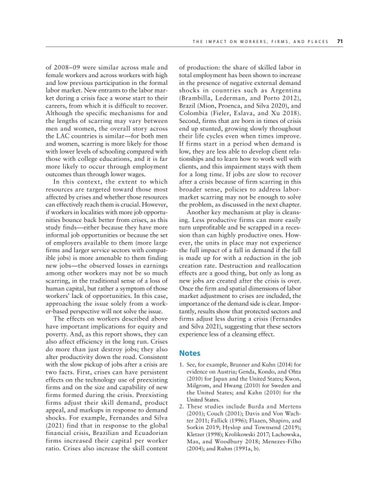T h e I m p ac t o n W o r k e r s , F i r m s , a n d P l ac e s
of 2008–09 were similar across male and female workers and across workers with high and low previous participation in the formal labor market. New entrants to the labor market during a crisis face a worse start to their careers, from which it is difficult to recover. Although the specific mechanisms for and the lengths of scarring may vary between men and women, the overall story across the LAC countries is similar—for both men and women, scarring is more likely for those with lower levels of schooling compared with those with college educations, and it is far more likely to occur through employment outcomes than through lower wages. In this context, the extent to which resources are targeted toward those most affected by crises and whether those resources can effectively reach them is crucial. However, if workers in localities with more job opportunities bounce back better from crises, as this study finds—either because they have more informal job opportunities or because the set of employers available to them (more large firms and larger service sectors with compatible jobs) is more amenable to them finding new jobs—the observed losses in earnings among other workers may not be so much scarring, in the traditional sense of a loss of human capital, but rather a symptom of those workers’ lack of opportunities. In this case, approaching the issue solely from a worker-based perspective will not solve the issue. The effects on workers described above have important implications for equity and poverty. And, as this report shows, they can also affect efficiency in the long run. Crises do more than just destroy jobs; they also onsistent alter productivity down the road. C with the slow pickup of jobs after a crisis are two facts. First, crises can have persistent effects on the technology use of preexisting firms and on the size and capability of new firms formed during the crisis. Preexisting firms adjust their skill demand, product appeal, and markups in response to demand shocks. For example, Fernandes and Silva (2021) find that in response to the global financial crisis, Brazilian and Ecuadorian firms increased their capital per worker ratio. Crises also increase the skill content
of production: the share of skilled labor in total employment has been shown to increase in the presence of negative external demand rgentina shocks in countries such as A (Brambilla, Lederman, and Porto 2012), Brazil (Mion, Proenca, and Silva 2020), and Colombia (Fieler, Eslava, and Xu 2018). Second, firms that are born in times of crisis end up stunted, growing slowly throughout their life cycles even when times improve. If firms start in a period when demand is low, they are less able to develop client relationships and to learn how to work well with clients, and this impairment stays with them for a long time. If jobs are slow to recover after a crisis because of firm scarring in this broader sense, policies to address labor- market scarring may not be enough to solve the problem, as discussed in the next chapter. Another key mechanism at play is cleansing. Less productive firms can more easily turn unprofitable and be scrapped in a recession than can highly productive ones. However, the units in place may not experience the full impact of a fall in demand if the fall is made up for with a reduction in the job creation rate. Destruction and reallocation effects are a good thing, but only as long as new jobs are created after the crisis is over. Once the firm and spatial dimensions of labor market adjustment to crises are included, the importance of the demand side is clear. Importantly, results show that protected sectors and firms adjust less during a crisis (Fernandes and Silva 2021), suggesting that these sectors experience less of a cleansing effect.
Notes 1. See, for example, Brunner and Kuhn (2014) for evidence on Austria; Genda, Kondo, and Ohta (2010) for Japan and the United States; Kwon, Milgrom, and Hwang (2010) for Sweden and the United States; and Kahn (2010) for the United States. 2. These studies include Burda and Mertens (2001); Couch (2001); Davis and Von Wachter 2011; Fallick (1996); Flaaen, Shapiro, and Sorkin 2019; Hyslop and Townsend (2019); Kletzer (1998); Krolikowski 2017; Lachowska, Mas, and Woodbury 2018; Menezes-Filho (2004); and Ruhm (1991a, b).
71

